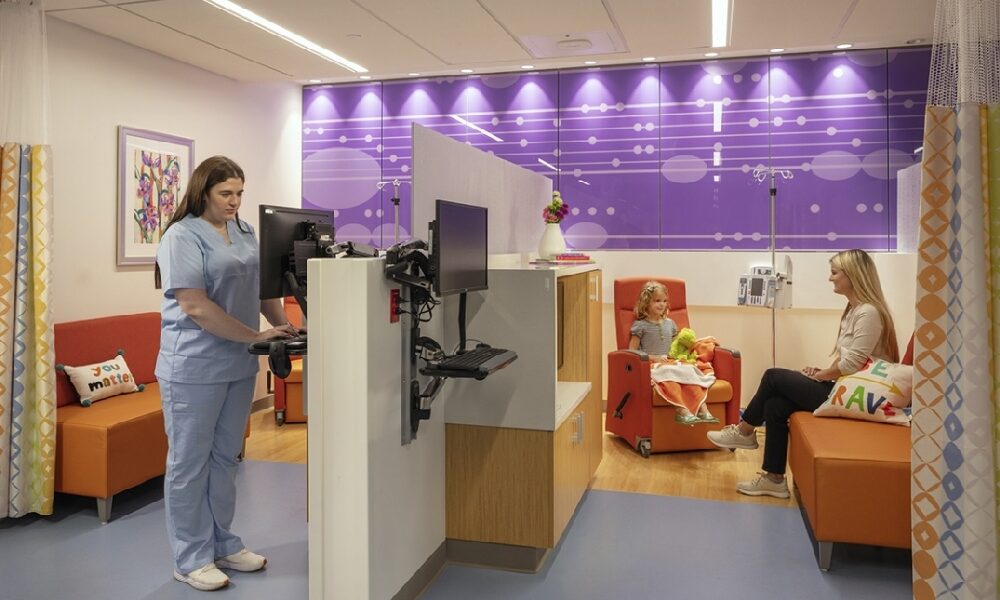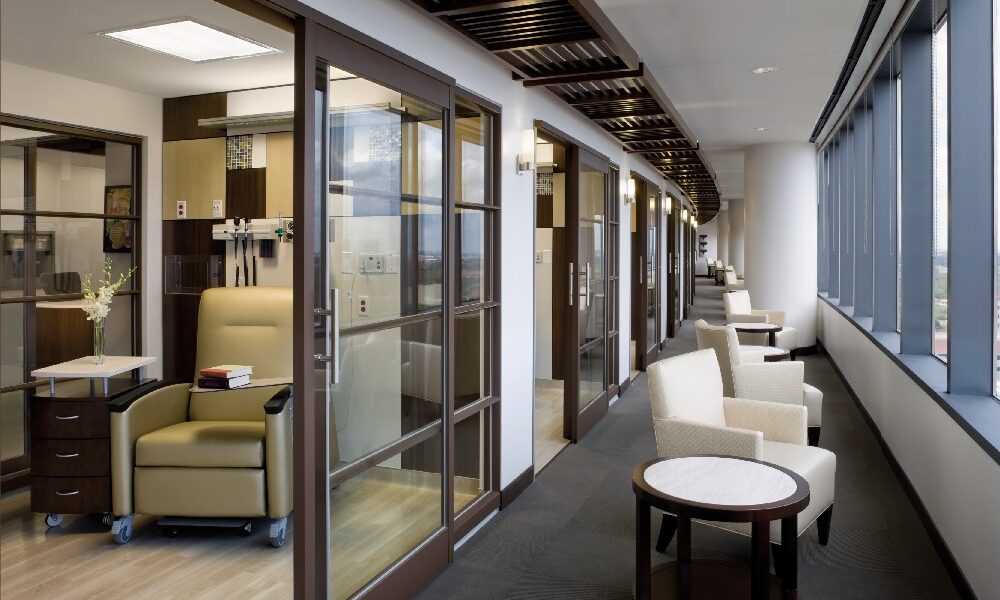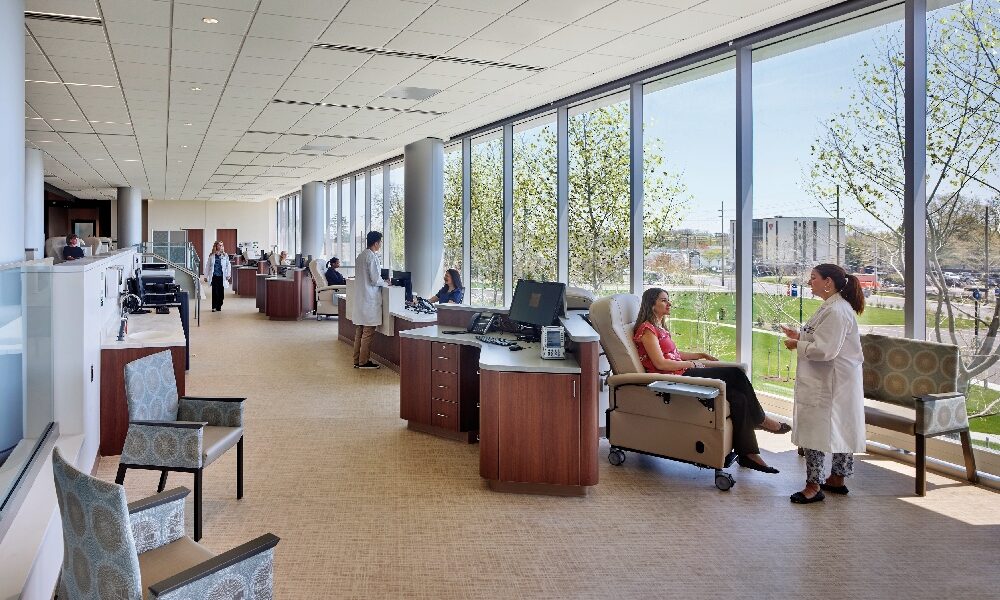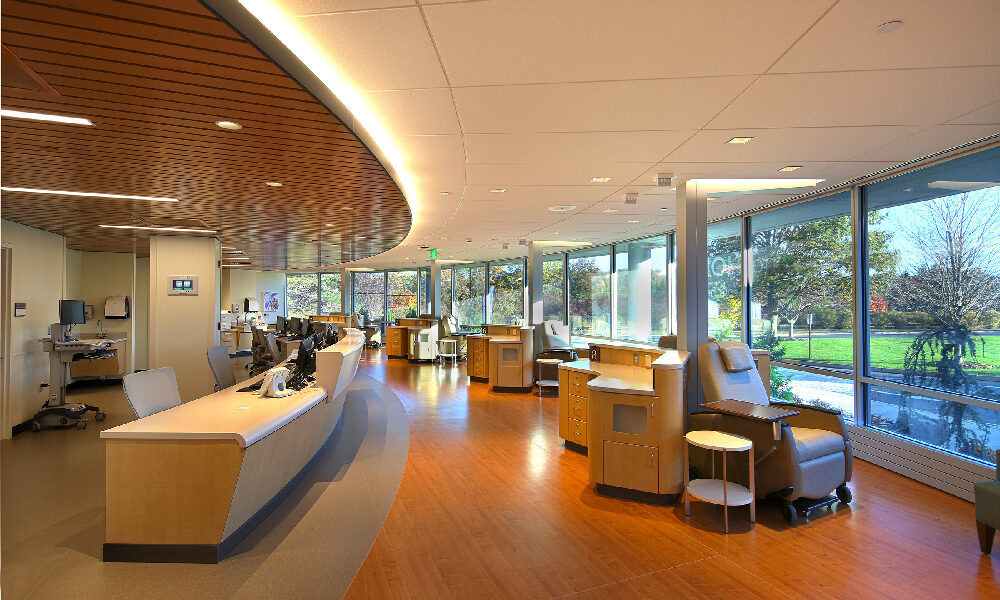 Children’s Hospital New Orleans’ pediatric infusion center has a brightly colored, child-friendly design with two semi-private pods separated by a divider and comfortable sitting space for a parent, as well as a work station for an infusion nurse. Photo © Jim Roof Creative, Inc.
Children’s Hospital New Orleans’ pediatric infusion center has a brightly colored, child-friendly design with two semi-private pods separated by a divider and comfortable sitting space for a parent, as well as a work station for an infusion nurse. Photo © Jim Roof Creative, Inc.  Houston Methodist Outpatient Center has private infusion rooms with sliding doors and a connected "patio" which features a wooden canopy and wall sconces. The patio provides an opportunity for visitors to briefly step out of the room and make conversation with other visitors. Photo © Aker Imaging.
Houston Methodist Outpatient Center has private infusion rooms with sliding doors and a connected "patio" which features a wooden canopy and wall sconces. The patio provides an opportunity for visitors to briefly step out of the room and make conversation with other visitors. Photo © Aker Imaging.  Hackensack Meridian Jersey Shore, the sister facility to Hackensack Meridian Ocean University Medical Center, also offers expansive views and bright window seats, while providing a work station for infusion staff, ample storage and comfortable seats for family/friend support. Photo © Halkin Mason Photography.
Hackensack Meridian Jersey Shore, the sister facility to Hackensack Meridian Ocean University Medical Center, also offers expansive views and bright window seats, while providing a work station for infusion staff, ample storage and comfortable seats for family/friend support. Photo © Halkin Mason Photography.  Hackensack Meridian Ocean University Medical Center design provides ample patient views to the landscape, while offering direct sightlines from the nurse station. The design was developed to provide a clean, open layout as well as a nearby area for clinicians to comfortably deliver care to each patient. Photo © Hackensack Meridian Health.
Hackensack Meridian Ocean University Medical Center design provides ample patient views to the landscape, while offering direct sightlines from the nurse station. The design was developed to provide a clean, open layout as well as a nearby area for clinicians to comfortably deliver care to each patient. Photo © Hackensack Meridian Health. Subscribe Now
First-Class Infusion Spaces
By Sarah Walter & Renee Fiala
Designing infusion areas that prioritize patient choice, comfort
You’re stuck in an uncomfortable seat for hours with little choice as to where you sit, limited control over the temperature and no control over your view. Your seatmate insists on chatting when all you want to do is take a nap. This sounds like a typical on-flight experience for airline passengers, but it could just as easily describe the experience of patients undergoing oncology infusion therapy, as well. Receiving care for a cancer diagnosis shouldn’t feel like flying coach. Healthcare designers are moving toward providing infusion patients first-class accommodations, with more comfort, choices and control over their experience.
The CDC predicts a 50% increase in the total number of cancer diagnoses in the U.S. by 2050. Generally, the risk of being diagnosed with cancer increases with age, and this anticipated increase in cancer cases is largely driven by a growing and aging population. The baby boomer and Gen X populations are living longer, so there is a larger population reaching a higher-risk age group.
While innovations and options for cancer treatment continue to grow, infusion therapy remains a common course of treatment. Patients’ safety, comfort and sense of control are central to infusion center design. Elevating the patient experience is not only the right thing to do, it’s a smart business decision. Patients have more options available to them about where to receive cancer care, as well as higher expectations. Spa-like amenities, calming décor, scenic views and a range of privacy options are trends quickly becoming standard in the industry, whether medical clients are building new infusion centers or renovating existing spaces.
And for good reason: In addition to affecting mental and emotional well-being, research continues to show that the built environment has the power to affect behavior and treatment outcomes. For example, patients who have support are more likely to have a better outlook and to adhere to and engage in their treatment plan, so it’s important to include design elements that encourage the presence of a friend or family member at infusion treatments.
By ensuring that care environments inspire a sense of hope and offer patients comfort and control in addition to efficiency and safety, we can assist patients in their journey from diagnosis to survivorship to reclaiming their lives.
Comfort & control
One oncology patient described his first experience at the infusion center: “I laid out my outfit the night before. I brought snacks. I was nervous. But there was something exciting about those initial visits. Chatting with my lab techs, getting to know my nurses. There were questions to be asked and crossword puzzles to do.” As the infusion sessions progressed, however, they soon lost their novelty. “Now that I’m on treatment six, small talk is harder. I’ve caught up on all my podcasts, and I don’t feel like reading. I’d rather be at the beach or at work – anywhere but hooked up to this IV. Not that I’m not thankful. I’d rather have boring chemo than exciting cancer.”
Good design can ease discomfort and monotony, but one design may not fit all. What patients want is more control over their own experience. As we think about the different spaces in which patients receive infusions, we must think about balancing privacy and visibility. Patients shouldn’t feel “on display” as they sit for hours receiving treatment. At the same time, cancer drugs can cause serious reactions and patients require close monitoring. The most effective designs allow varying levels of privacy, while allowing staff to keep high-risk patients in sight.
At infusion appointments, some patients want to build a support network; others desire a quick in-and-out visit. For those feeling well enough to enjoy socializing, infusion centers can provide opportunities for connection. Patients might binge favorite shows together, or chat with the staff and each other. Some value calmness and serenity, preferring semi-private bays facing gardens or woods. On their worst days, infusion patients might need to lie down in a dark, quiet space. To address this need for a range of different – and at times conflicting – environmental requirements, we often provide a mix of semi-private and private infusion stations. In more private spaces, visibility can be addressed through design details: sliding glass doors, patterned windows, even technology-based solutions like physiological monitors, similar to those used in inpatient settings.
Some innovative centers are requesting outdoor gardens or shaded patio spaces that allow patients to enjoy nature and fresh air while undergoing infusion. Research has long shown the benefits and positive outcomes associated with views to nature; this new infusion garden concept offers opportunities for a more immersive relationship to nature, which certainly improves the patient experience and could further improve treatment outcomes.
Patients long for the normalcy of their pre-cancer lives, and by designing care spaces that minimize and de-emphasize the clinical aspects of treatments, design can offer that sense of normalcy. Devising options that fit each patient’s needs on each visit is the most universal challenge we face in designing infusion spaces.
We’ve designed spaces for special cancer care delivery models with spa-like environments in a private room separate from the regular infusion bays – some even have “living room” areas with fireplaces or “front porches” with scenic views that provide comfortable seating for waiting. And the comfort of small touches cannot be overstated. Personalized amenities include easily adjustable chairs that warm up, heated blanket and radiant-heat flooring, especially popular in colder climes. Infusion liquids can be cold and make patients feel chilled. In addition, some patients have lost their hair and body fat, and are prone to being chilly. We try to make the environment warm and cozy.
Adaptability and flexibility are key. For example, as designers, we often envision the infusion chairs staying right where we draw them. But they can be moved into circles around a coffee table, and sofas and lounge chairs can be placed adjacent to the care stations. For pediatric patients, soft mats can be put on the floor for infants to lie on and toddlers to play on while receiving infusions. Adolescents may have treatment lounges with gaming, art stations and movies.
Ultimately, we would like to see infusion centers offer as much choice as airlines, with patients picking their seat placement, amenities and level of privacy before they arrive. Or they could have a preference card on file, saying they’d prefer to sit by a window or close to a restroom. The more choices we offer, the more a patient can regain some sense of control.
Safety & efficiency
Traditionally, infusion centers had an “open bay” design: a row of chairs in a wide-open space that enhanced visibility for medical staff. With open bays, we worked toward a design that provided some privacy through curtains, while maintaining safety.
Now, the line is more frequently blurred between open and semi-private bays by incorporating low, half-height walls with decorative translucent panels (replacing curtains) that continue up to the ceiling. This approach gives seated patients privacy, but allows full view of the area from a standing position, so staff can monitor patients with ease. Providing a floor-to-ceiling physical separation between care stations also mitigates noise, as does acoustic ceiling tile. We also try to stagger infusion stations, so patients are not directly across from each other.
One pediatric facility client recently asked that we locate their private infusion rooms across from their care team station for higher-acuity patients, who are more likely to have an adverse reaction. These private rooms feature glass-sliding doors and physiological monitoring capabilities. This placement also protects other patients from the stress of a code situation.
Indeed, thoughtful design can enhance the patient experience by concealing distractions and logistics that are part of any infusion center’s operations.
At one infusion center, we came up with an “island” concept to address many of these issues: a unit to define the infusion bays with a half-wall between chairs, offering a place of refuge to the patient. The island contains storage for belongings, controls for window shades and lighting and a nurse-call device, as well as adjacent clinical space, PPE storage and a countertop work surface for the nurse. It also serves as a docking station for medical gases, blood pressure monitors, biohazard and chemical waste bins and sharps disposal. This fosters the look of an orderly, uncluttered environment while keeping important items at arm’s reach.
In private infusion rooms, space must be carefully managed. We maximize the use of walls and cabinets to eliminate clutter and provide storage. Creating separate zones in the room for patient, support person and nurse is essential, so no one is tripping over each other or the equipment. Space for the patient’s friend or family member, including a comfortable place to sit, should be closest to the patient, so they never feel in the way or brushed aside.
We have found a separate and dedicated corridor that is “off stage” can be helpful in minimizing noisy disruptions from environmental services and materials management re-stocking activities. This off-stage area is where nurses and other staff have access to break rooms, supply rooms, soiled linen and laundry refresh rooms, the satellite pharmacy, etc., without disturbing patients. When optimizing flow, keep in mind a safe and discreet way for emergency response teams to enter the building and quickly get to patients in distress, with wide elevators, corridors and doorways to accommodate stretchers.
Infusion patients should have proximity and a clear, unobstructed path to a restroom. Due to the amount of fluid administered during infusions, patients require restrooms more frequently, and will be traveling with IV pole in tow. We try to group toilets in pairs, so patients aren’t left searching for an open restroom.
Flexibility & the future
The part of infusion center design that receives the most attention is usually the infusion bay, since it is where patients spend the most time. Designers must look beyond the bay, however, to consider the entire patient journey: arrival onsite, parking, check-in, waiting, etc. Patients undergoing cancer treatment are often weaker and tire more quickly, so planning for ample parking and clear wayfinding near the building entrance is key. Some medical facilities offer free valet drop-offs with concierge-like services similar to what might be available in an upscale hotel.
As medical designers, we frequently borrow design details from the hospitality industry. Instead of a long, imposing check-in desk, clients today tend to prefer a series of smaller, standing-height desks. After one facility requested a way to display each registrar’s name, our environmental graphic design team developed a system of interchangeable plates, inscribed with individual names that slid into front desk pockets.
Once inside the center, co-located services create a “one-stop shop” for patients seeking streamlined cancer care. Most infusion centers also have outpatient exam rooms and are including specialties like radiation oncology. Typically, there’s a process for “day of” lab work to verify a patient’s platelets, white and red blood cell counts, etc., ensuring it’s safe for the patient to receive their infusion. Some patients may arrive for lab-only visits. We usually plan for a dedicated blood-draw area near check-in.
To help patients manage the side effects of treatment, comprehensive cancer centers may include integrative medicine and support services such as physical therapy, counseling, massage therapy, Reiki, acupuncture, yoga and cooking demonstrations, which require kitchen, meeting and classroom spaces.
Cancer treatment is challenging and full of uncertainty. We believe environments for cancer care and infusion therapy should continue to evolve and soften, to become less intimidating and clinical and more supportive and comfortable.
Author: Sarah Walter & Renee Fiala
Sarah Walter, AIA, is a senior medical planner, EYP Atlanta, Georgia. Renee Fiala, AIA, EDAC, is a senior medical planner, EYP Houston, Texas.
Tags: Architecture, infusion spaces
Posted June 14, 2022
More Articles:
- State of Industry Examined in ‘Healthcare Reset’ Report
- Cam Twohey Joins Kahler Slater as Associate Principal, Senior Project Architect in Healthcare Market
- Perkins Eastman Welcomes Michael Hess as Principal in New York Studio
- Guerin Children’s Inpatient Pediatric Unit at Cedars-Sinai Provides Interactive, Family Friendly Healing Environment
- CxA Workshop & Exam
Apr 29, 2024 – Apr 30, 2024 - EMP Seminar & Exam at CxEnergy 2024
Apr 29, 2024 – Apr 30, 2024 - CxEnergy
Apr 29, 2024 – May 2, 2024 - PHCC West 2024
Apr 29, 2024 – May 2, 2024 - Lean in Design Forum 2024
May 1, 2024 – May 2, 2024 - IFMA’s Facility Fusion Conference & Expo
May 5, 2024 – May 7, 2024 - ASHE Academy 2024
May 6, 2024 – May 10, 2024










